Undergrad summer student research positions explored
The following is part of a series introducing CivMin’s undergraduate summer students to the Department and our greater community.
We explore the students’ projects, motivation and challenges, while providing insights into who they are, and what motivates them, beyond academia. It also highlights the multitude of ways summer research opportunities are approached and implemented under the guidance of our industry-leading CivMin professors.
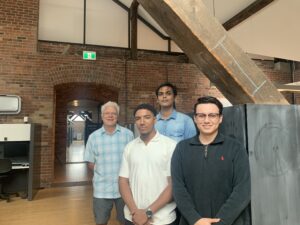
Rain Ferrer (MinE, Year 3), Anass Janah (Work-Study Student, Civil Engineering, Year 4, CESI de Bordeaux, France) and Madhavan Premrajka (Mining Engineering, Year 4, IIT Kharagpur, India) are all doing research under the supervision of Professor John Harrison this summer. When Rain heard about the research opportunity with Prof. Harrison, he immediately knew it was a position he couldn’t miss out on.
Anass and Madhavan join the team this summer as part of the Mitacs Global Research Initiative, which connects students with post-secondary institutions around the world for unique learning opportunities. Anass is pursuing a career in Civil Engineering in France, whereas Madhavan is pursuing Mining Engineering in India. India has been involved in this Mitacs initiative for years, and this is the first year France has participated.
Tell us a bit about yourself.
Rain Ferrer: I just finished my third year of [Lassonde] Mineral Engineering. I’m going to be leaving at the end of the month for my work term and then I’ll be back at school for my final year. I’m from Toronto.
Anass Janah: I’m from Bordeaux, France. I’m currently working in a smart grids company in a city near Bordeaux as an apprentice in a work-study program. I’m in my fourth year of Civil Engineering.
Madhavan Premrajka: I’m from the Indian Institute of Technology in Kharagpur, India, and I’m going into my fourth year of Mining Engineering.
What will be your role this summer and where? What types of tasks and work will you be doing? What’s the research goal?
Rain: I’m a student researcher. I work with the software, R. I would say the end goal of my research is to identify the design stress state* for underground excavations. It’s about statistically characterizing the in-situ stress conditions to use in design calculations for underground excavations.
*Design stress state context (provided by Prof. Harrison): As you go deeper down into the water, pressure increases. The same happens in rock, except it’s much more complex. When we measure the state of stress in the ground in different locations, we get different values. The question is, which value should we use for our design? We don’t know. That’s what we call the design stress state. Rain’s been doing statistical modelling to see if we can learn something about how to determine design stress states.
Anass: I’ve started to learn R [a programming language for statistical computing]. I’ve learned the language and how to manipulate data, but still have a lot to learn. It’s new for me. I work with statistical modelling, so I apply this software to mineral engineering. Last week, I started to work with Amir Javaid [PhD candidate]. My work consists of checking whether the evolution of stress with depth follows a mathematical model.
Madhavan: Most of my work has been done in the computer lab on the fourth floor [of the Lassonde Mining Building]. I’ve been working with R and the software called OpenBUGS [software for performing Bayesian data analysis]. My goal has been to identify the effects of anisotropy of rock strength and in situ stress on the stability of underground excavations.
If you want to learn to swim, for example, you have to go to the pool.
How did you learn the software required for your research?
Rain: I’m still learning; I pick up something new every week. I gained a working knowledge of R after about two weeks, give or take. There was a steep learning curve. Of course, there’s experiential learning, but Prof. Harrison provided a lot of reading material online which gave me a jumpstart on [learning]. Being immersed in Prof. Harrison’s worksheet was also very useful for learning.
Anass: If you want to learn to swim, for example, you have to go to the pool. I just had to start working on the project – on something tangible. That’s the way I learn.
Madhavan: I started with the worksheet on R, provided by Prof. Harrison. Then, as I started working with the data, I learned new things as we went on. Starting with solely the data and software would have been very difficult [without the worksheet].
What motivated you to work with Prof. Harrison on this project?
Rain: Prof. Harrison was my [MIN329] Rock Mechanics professor in the fall of 2022 . Towards the end of the term, he very kindly offered me this position. At the time, it was seven months in advance. I was immediately thrilled to hear about the opportunity and made sure I didn’t miss it. So, here I am; it was a decision I’m very happy about.
Anass: I am very passionate about geotechnical [engineering] because of the internship I did with a foundation company involving a lot of work with Eurocode 7 [the European standard describing how to design geotechnical structures]. Prof. Harrison also has a background in working with Eurocode 7.
Madhavan: The professors apply for Mitacs first; they submit the projects students can work on. When I was applying for Mitacs, projects related to mining and rock engineering were very limited; there were about 20 of them. The basic premise of the material Prof. Harrison submitted was to provide a student with research experience, and I wanted research experience. What finalized the decision for me was Prof. Harrison and I’s talk online; he was the only one who wanted to talk. I applied for seven projects and only Prof. Harrison spoke with me. I wanted to work with a professor who would talk with students.
What do you foresee being your greatest challenge?
Rain: I think my greatest challenge for the first half of the summer was time management. I was working here [at U of T], taking two summer courses for my business minor and working at my part-time job. Managing all of those and distributing enough time for each of them was a challenge. There were a lot of late nights, but I would definitely do it again. It all worked out.
Anass: As a foreigner, getting used to the city and the North American mentality [was my greatest challenge]. Also, being far from my family. I’ve always lived in France and grew up there, so it’s a big trip for me. A technical challenge was getting used to R and all the things I didn’t know before.
Madhavan: Initially, [my greatest challenge] was getting used to Toronto. It’s different compared to where I’m from. I’m not used to the weather. When I initially arrived, [the temperature] was in the single digits and I’m not used to single digits at all. Beyond the weather, I would say learning R was probably the most difficult part.
Have you found any favourite spots on campus?
Rain: It’s hard to pick because I happen to think we have a really nice campus and there are lots of good spots. We generally meet on Willcocks Street, where traffic is blocked off and there are chairs, tables and umbrellas set up. I think it’s a great spot. Of course, when the weather is nice. Also, adjacent to University College, on the west side, there is a small parkette with benches where you can sit and work – it’s terrific.
Anass: Willcocks Street is a very nice spot. I also like to work in Study Commons, the study space in my residence on the 28th floor.
Madhavan: I used to go to Cora Pizza [close to campus] a lot and the lobby of New College.
As John Harrison says, research is never finished.
Is there anything I haven’t asked you about you’d like to speak on? Final thoughts?
Rain: Research has been a one-of-a-kind experience, no doubt about it. I’ve learned so much. I often reflect on how little I knew about the subject before I started. There’s so much you learn every week and you think, “of course, I didn’t consider that.” I really enjoy those “aha” moments. It’s been great.
Madhavan: As John Harrison says, research is never finished.
Do you have any interesting hobbies or talents you’d like to share?
Rain: When I’m not in the city, one place you can find me is at the family cottage. I like to go as often as I can and escape from the city for a weekend. I always enjoy going boating and using my chainsaw to cut down dead trees for firewood.
Anass: I’ve been doing sports since I was six years old. When I came here, I started to practice squash in the Athletic Centre. I’m getting better. In France, I did martial arts, kickboxing, and judo. Sports are my favourite hobby.
Madhavan: I like fiction in terms of both reading and writing. I’m in the process of writing a new fiction novel, but it’s in a very early stage.
Questions for Prof. Harrison:
What do you hope for Rain, Anass and Madhavan to achieve this summer? Any major takeaways?
Professor John Harrison: Madhavan, Anass and Rain are working on independent, but linked, projects. Each project gives them the full research experience. They’ve been given a problem and tools, and then have been tasked with understanding it and exploring if they can develop some sort of answer.
I hope they learn to research, obtain new results and determine if research is something they’d like to pursue in the future. For those who’ve come from outside Toronto, I don’t want them to just experience the University of Toronto – I want them to experience Toronto too.
Rain, Anass and Madhavan are contributing to the wider knowledge we have within the group. I’m also learning through them.
How will Rain, Anass and Madhavan be contributing to this project/your research?
Prof. Harrison: Rain, Anass and Madhavan are all working on aspects of the research I’m doing with my PhD students. None of them are directly contributing, but they are directly supporting what we’re doing. The PhD students I’m supervising will use parts of their work and include it in their own projects.
Rain, Anass and Madhavan are contributing to the wider knowledge we have within the group. I’m also learning through them. For example, today, Madhavan showed me some research results I’ve never seen before.
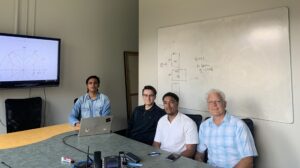
Where is the data Rain, Anass and Madhavan working with coming from?
Prof. Harrison: My PhD candidate Amir Javaid is working on a project with the Nuclear Waste Management Organization (NWNO), trying to identify two sites in Ontario they can use as deep geological repositories for radioactive waste. They have a research partnership with SKB [Swedish Nuclear Fuel and Waste Management Company], who has been doing this for the last 40 years. SKB has plenty of stress measurement data. As a result, Amir has been able to generate statistical characterizations of stress in Sweden. That’s the data Rain and Anass are using. Madhavan is using a different data set on the strength of a slate type of rock, from the work I did eight years ago with a previous PhD student, Nezam Bozorgzadeh.
Anass and Madhavan are here as part of the Mitacs Global Research Initiative. Do you have any comments to share about international research experiences?
Prof. Harrison: When Anass and Madhavan first arrived, I told them to be tourists for a week before starting research. I knew they wouldn’t be able to explore the city later.
At the end of the summer, I hope for Anass and Madhavan to be able to answer three questions. The first one is: do I like Toronto? The second one is: do I like research? And the third one is: do I like rock engineering? Being able to answer those three questions, regardless of the answer, is what I believe to be most important.
Do you have any interesting hobbies or talents you’d like to share?
Prof. Harrison: My fun fact is I’m a keen amateur researcher in aerodynamics and hydrodynamics, known as sailing to the rest of the world. It’s a very technical thing. Yesterday, when I was sailing with Madhavan, I was showing him how small adjustments in the sails make the boat behave very differently. I find it absolutely fascinating. And every day is different.
August 10, 2023 | CBC online
August 8, 2023 | CBC online
June 29, 2023 | MRO Magazine
Undergrad summer student research positions explored
The following is part of a series introducing CivMin’s undergraduate summer students to the Department and our greater community.
We explore the students’ projects, motivation and challenges, while providing insights into who they are, and what motivates them, beyond academia. It also highlights the multitude of ways summer research opportunities are approached and implemented under the guidance of our industry-leading CivMin professors.
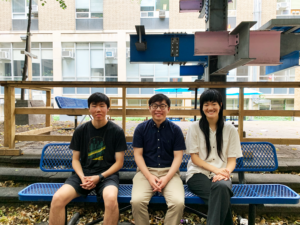
Chris Kim (EngSci, Year 2) and Catherine Ye (CivE, Year 4) are doing research about buildings and building systems this summer under the supervision of Professor Seungjae Lee. Both students are passionate about investigating and exploring the realm of building science. Chris is drawn to this research area because of its complexity and how interesting this makes the problem space, whereas Catherine is fascinated by the artificial intelligence and sustainability elements of building science.
Tell us a bit about yourself.
Chris Kim: [This September] I’ll be starting my second year in the Engineering Science program. I graduated from high school in Delta, B.C.
Catherine Ye: I go by Cat among my friends. I’m a fourth-year Civil Engineering student. I just finished a year of PEY Co-op. I grew up in Ottawa and have been living in Toronto since I moved here for U of T. I enjoy visual arts and drawing – anything in the creative realm.
What will be your role this summer and where? What types of tasks and work will you be doing? What’s the research goal?
Chris: I’m developing an optimal controller* for a building HVAC system using mainly reinforcement learning, which is a branch of artificial intelligence [AI] merged with control theory. My work is mostly done with Prof. Lee. I am developing and testing optimal control algorithms with a building model in a simulation environment.
I recently developed a model-free reinforcement learning algorithm but realized, while it was good at minimizing energy cost of a HVAC system, it had problems with other aspects of the building including thermal comfort and the lifespan of HVAC equipment. Now, I’m exploring whether model-based controllers work better than model-free reinforcement learning for HVAC systems.
*An optimal controller is designed to maximize/minimize an objective. In this case, the optimal controller is attempting to minimize energy consumption or energy cost and maximize occupant thermal comfort.
Catherine: I’m working with Prof. Lee on developing a building performance energy model for the U of T Exam Centre. One of Prof. Lee’s MEng students, Mayank Kumar, started building the model with the software we’re using called Design Builder. My role this summer is to further develop the model by adding the HVAC components to best represent the heating, ventilation, and cooling systems within the real building.
The goal by the end of the summer is to compare the simulated results with the real building’s operational data. There will be discrepancies. We must determine the sources of those discrepancies, what assumptions led to those discrepancies and then further fine-tune the model accordingly. The long-term goal is to use this model to inform decisions for reducing energy consumption. This is part of Professor Lee’s ongoing research project, Grid-Interactive Smart Campus Buildings. One of Prof. Lee’s PhD students, Chou Shen, will continue to use this model for their studies and work.
Buildings are very complex dynamical systems and have a lot of space and difficulties regarding domain knowledge to be integrated, making the problem space much more interesting.
What motivated you to work with Prof. Lee on this project?
Chris: The reason I’m interested in research in civil engineering and building science is because of my interest in dynamical systems** and how you can control and understand those systems. Buildings are very complex dynamical systems and have a lot of space and difficulties regarding domain knowledge to be integrated, making the problem space much more interesting. That’s what motivated me to contact Prof. Lee.
** A dynamical system is a mathematical concept used to describe the behaviour of a system that changes over time. A building is a dynamical system in the sense that indoor thermal conditions (e.g., temperature) change over time, affected by weather conditions, occupancy, HVAC operations, etc.
Catherine: I have an interest in building science. I had Marianne Touchie as a professor, so I reached out to her when I was interested in pursuing a research opportunity. She recommended I reach out to Prof. Lee. One of my PEY Co-op colleagues, Noah Cassidy (CivE 2T0, MASc 2T2), who recently finished his master’s degree under the supervision of Marianne Touchie, also recommended reaching out to Prof. Lee.
I looked through Prof. Lee’s research projects and found [his projects and research] very much aligns with my interests. I found it especially interesting how he works with AI and how it integrates into the building science world. It’s an interesting and fascinating niche. He also has projects related to analyzing human behaviour and how humans occupying buildings impact energy.
What do you foresee being your greatest challenge?
Chris: The challenge is understanding different domains [of knowledge] that must tie together. I often use domain knowledge and physics regarding thermodynamics, building science and AI. All three of those fields are ones I am not an expert in or have much knowledge about. I must understand it enough to apply it. And gaining this understanding from reading online has some challenges. This is a challenge I have had since the very beginning, and I assume it will continue to be one.
Catherine: A challenge I’ve been learning to navigate is the shift from having a nine-to-five structured work environment to the flexibility of this research opportunity. My PEY Co-op was in a consulting environment where everything is very clearly outlined – you have x,y,z amount of time to do exactly this and it must be delivered by this time to this person. I enjoyed the structure because it kept me motivated and accountable.
This research opportunity is very exciting. The fact that it’s so flexible, remote and less strict is not a bad thing by any means but I feel less pressure with the research project because I don’t have a huge deliverable due by tomorrow, for example. There’s always something to do but it’s easy to procrastinate. I asked Prof. Lee to start meeting twice a week instead of once a week because it helps keep me more accountable.
Have you found any favourite spots on campus?
Chris: Lash Miller Laboratories [located in the A.D. Allen Chemistry Library] on the fourth floor is pretty nice. Not many people know about the place. My friends and I go there often to study. Hart House is also very nice, especially the gym there. They always have events going on in Hart House too.
Catherine: In my first year, I would often go to the University College common rooms, which was a fun space anyone can go to study. There are bookshelves and dark wood. The ambience feels very academic, but also warm; they have couches if you want to take a nap – I did. There’s also a little coffee shop in the building next to it. I haven’t been there since my first year, but it was fun.
I hope incoming students come across building science and the sustainable energy realm related to the built environment and buildings sooner.
Is there anything I haven’t asked you about you’d like to speak on? Final thoughts?
Chris: I’m really glad I discovered more about buildings and various aspects of the building. Before, I didn’t fully understand what was going on behind–the–scenes [of buildings] and what to consider for developing very fine–tuned controllers and HVAC systems. I’ve gained a greater understanding of this process and appreciate it more.
Catherine: I have a personal anecdote [to share]. I hadn’t discovered what building science was until my third year when I took the Building Science [CIV375] course, a mandatory class for Civil Engineering students. It completely opened my mind up to this industry I had no idea existed. I hope incoming students come across building science and the sustainable energy realm related to the built environment and buildings sooner. And I hope it interests and excites them because it’s important, especially for addressing the climate crisis in an interesting and impactful way.
Do you have any interesting hobbies or talents you’d like to share?
Chris: I can type over 110 words per minute. I naturally started doing it and the speed just came. I also like to play badminton and basketball – I’ve played at Hart House. I played varsity Badminton in high school; in my senior year, my team was regional champions.
Catherine: I enjoy visual arts and drawing. I’m also a tattoo artist on the side. I picked it up in the first pandemic summer. I think it’s a cool and interesting art form because it’s so personal. I like how folks can get tattoos that don’t mean anything and also can mean everything. That’s the beauty of the medium. I’ve given myself one tattoo, not because I don’t want to do more but because I enjoy collecting tattoos from different artists. To me, that’s the fun in it.
Questions for Prof. Lee:
…It’s all about gaining some comprehensive understanding and knowledge about how things work in the real world.
What do you hope for Catherine and Chris to achieve this summer? Any major takeaways?
Professor Seungjae Lee: Catherine and Chris are in very different situations. Catherine is starting her last year in September and Chris has just finished his first year. I hope for [Chris and Catherine] to gain some comprehensive knowledge and first-hand experience in dealing with buildings and building systems. Catherine has taken some building science courses and she’s worked at a building science consulting company, so she has a certain level of knowledge. I want her to further understand how components in buildings interact, how they behave in real buildings and how they impact building energy consumption and performance. It’s difficult to gain such comprehensive knowledge based only on lectures.
When Chris reached out to me, he was interested in solving dynamical system control problems and he already had a good level of coding knowledge and understanding of controllers and dynamical systems. After this summer’s research, I hope Chris will be able to understand even if you know how controllers and buildings work, once you try to solve a real problem, you will encounter many real problems you haven’t thought about. I want Chris to realize the challenges of dealing with real problems and real applications. I think it’s all about gaining some comprehensive understanding and knowledge about how things work in the real world.
How will Catherine and Chris be contributing to this project/your research?
Prof. Lee: What Catherine is doing is part of a bigger project. My PhD candidate, Chou Shen, is leading the research project. We are trying to optimize the operation of HVAC systems in the Exam Centre. To develop the controller and test the controller before implementing or deploying it to the real building, we need a virtual testbed***. The model Catherine is developing will be used as a testbed for that project. In addition, Catherine’s model will help the U of T Facilities and Services improve the performance of the building.
Chris is assisting with one of my major research interests – to develop optimal controllers for building HVAC systems. There are many ways to tackle this problem. Chris has a good level of knowledge of these kinds of techniques. My plan is to have a group meeting at the end of the summer for Chris to demonstrate what he has done during the summer. Findings from Chris’s work will help my master’s and PhD students. He’s comparing different algorithms and such results will help my students understand the pros and cons of different algorithms in optimizing building systems.
***A testbed is an environment or platform where researchers can conduct experiments or tests of their technologies/algorithms/techniques. In this project, we will test various control approaches using the building model as a virtual testbed.
Is there anything I haven’t asked you about you’d like to speak on? Final thoughts?
Prof. Lee: I tried to make these summer projects align with their interest and I hope they help their career development and future career planning. Other undergrad students may also find these kinds of opportunities help make sense of their future and plan.
Do you have any interesting hobbies or talents you’d like to share?
Prof. Lee: These days, I’d say I’m very good at changing diapers. And I’m very good at understanding what my six-month-old boy wants.
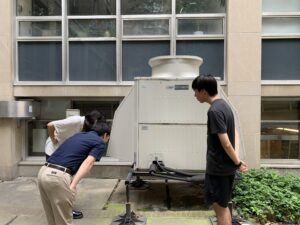
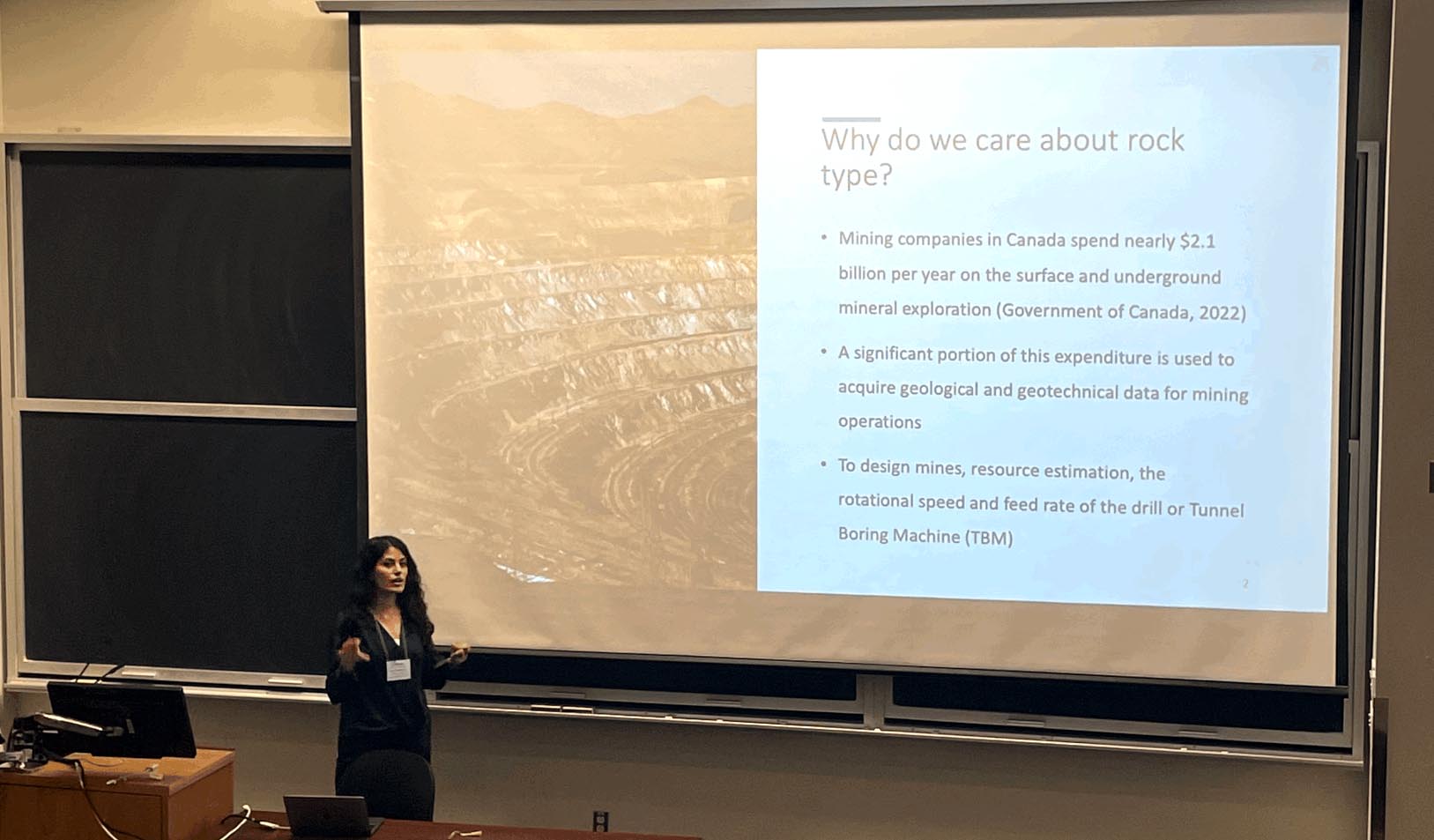
Negin Houshmand, a PhD candidate under the supervision of Professors Kamran Esmaeili and Sebastian Goodfellow, has won a first place award for their presentation at the University of Toronto Research Conference (UTERC) 2023.
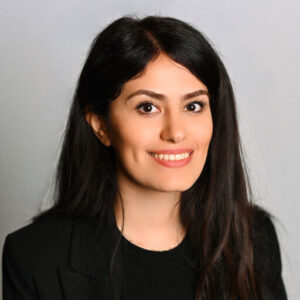
Houshmand presented her research to date in the talk, Rock Type Classification Using Machine and Deep Learning Approaches, resulting in a first place for Oral Presentation Award in Analytics & AI. This is a novel approach to predicting rock types which include both rock image and rock characteristics. Her presentation stood out among eight other speakers in the category to claim the top spot at the Wednesday, August 2 event.
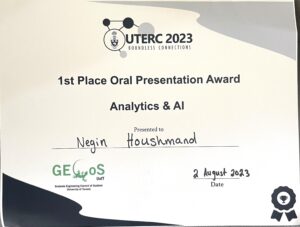 “With the advance of technology, digital core logging is becoming increasingly common in mineral exploration and deposit appraisal activities.” offers Prof. Esmaeili. “Using multi-sensor core logging data, Negin is developing cutting-edge AI solutions for more precise geological and geotechnical rock classification. This can consequently reduce uncertainty and risk in mine planning and design and the ultimate cost of a mining project.”
“With the advance of technology, digital core logging is becoming increasingly common in mineral exploration and deposit appraisal activities.” offers Prof. Esmaeili. “Using multi-sensor core logging data, Negin is developing cutting-edge AI solutions for more precise geological and geotechnical rock classification. This can consequently reduce uncertainty and risk in mine planning and design and the ultimate cost of a mining project.”
In their LinkedIn post Houshmand remarks, “I had the opportunity to present a part of my PhD work at the University of Toronto Engineering Research Conference 2023, and I was honored [sic] to win the 1st place for the Oral Presentation Award in Analytics & AI. Thank you University of Toronto for providing this amazing opportunity to learn from other students and share our ideas.”
By Phill Snel
Previous stories about Negin:
Femina Collective Scholarship winners: Negin Houshmand and Katia Ossetchkina
Undergrad summer student research positions explored
The following is part of a series introducing CivMin’s undergraduate summer students to the Department and our greater community.
We explore the students’ projects, motivation and challenges, while providing insights into who they are, and what motivates them, beyond academia. It also highlights the multitude of ways summer research opportunities are approached and implemented under the guidance of our industry-leading CivMin professors.
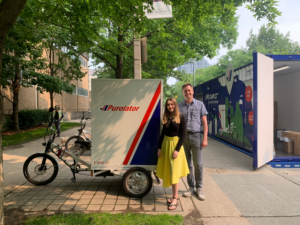
From her first taste of transportation research, Lisa Guseva (CivE, Year 4) knew she wanted to pursue a career in the area. This summer, Lisa will be exploring e-cargo tricycle parking, under the supervision of Prof. Matt Roorda, Usman Ahmed (Postdoctoral Research Fellow leading the program with Purolator) and Farah Ghizzawi (PhD candidate researching commercial vehicle parking and behaviour simulation). Lisa’s work will be part of a larger project, in partnership with Purolator, examining the performance of e-cargo bikes from a business, environmental and safety perspective.
Tell us a bit about yourself.
Lisa Guseva: I’m a fourth-year Civil Engineering student pursuing a career in transportation. I’ve had the opportunity to participate in research projects for the past three summers. This summer, I am working with Prof. Roorda on the Purolator e-cargo tricycle project.
What will be your role this summer and where? What types of tasks and work will you be doing? What’s the research goal?
Lisa: I’m working with [Prof. Roorda and his team] on his Purolator project. There are three different [focuses] for my research [this summer]. The first is data querying. This involves exploring all the datasets available related to parking e-cargo tricycles, and any parking-related datasets in general. Second, I’m working on writing a literature review to be submitted for publication in a journal. My last focus is on gathering data. We’re walking around the study area and gathering parking-related datasets. This includes the distances between parking poles and Green P parking data and the tricycle’s longitude and latitude. We’re still in the process of gathering data, but I’ll be analyzing it soon.
What motivated you to work with Prof. Roorda on this project?
Lisa: In the summer following my first year, I worked with Professor Eric Miller [who focuses his research investigations within the area of transportation], and I really liked it. I decided I wanted to try a new area in transportation, and reached out to Prof. Roorda, which ended up working out. The area of transportation has been my desired career path for a while now.
What do you foresee being your greatest challenge?
Lisa: [My greatest challenge is] the literature review I’m working on. There’s not a lot of parking-related information available – it’s very specific and not a lot of studies have been done on e-cargo tricycles, especially the parking of e-cargo tricycles. And [the literature review] takes very in-depth research to write.
Have you found any favourite spots on campus?
Lisa: The Lassonde Mining Building. I usually do my work there because I like the common room. It’s also very exclusive and distraction-free.
Is there anything I haven’t asked you about you’d like to speak on? Final thoughts?
Lisa: [Some friends are I] are developing an app aimed at getting people to switch from cars to lower emission modes of transportation. We spent all last year working on it, and we’re going to continue in the fall. We’re planning to partner with local businesses in Toronto to create a point system. Whenever someone travels by walking, public transportation or cycling, they would earn a certain number of points, determined by the distance they travelled. [The points] could then be used at local stores, for example. It would drive traffic to businesses and at the same time, keep people using our app. It also compares different routes and how many emissions would be released if you used different modes of transportation.
Do you have any interesting hobbies or talents you’d like to share?
Lisa: I do trap shooting – someone throws a bunch of flying targets in the air and you shoot them, and I do 25-yard targets. I’m also on U of T’s Target Sports Student Association too.
Questions for Prof. Roorda:
What do you hope for Lisa to achieve this summer? Any major takeaways?
Prof. Roorda: Lisa is part of a larger project involving several students. We’ve been working with Purolator for about seven to eight years now. We have an electric cargo tricycle facility, installed last summer and launched in Fall 2022. E-cargo tricycles are travelling around campus and in nearby neighbourhoods delivering packages in replacement of trucks. The overarching project is to examine the performance of e-cargo tricycles from a business, environmental and safety perspective.
Lisa’s focusing on the parking element of e-cargo tricycles. This starts with exploring background literature and then involves tracking the e-cargo tricycles with GPS. I hope for Lisa to match the e-cargo tricycles GPS data with parking spot locations. That’s the data collection element of Lisa’s work. Then, she’s examining how much of a benefit these tricycles are compared to illegally parked trucks or trucks idling and blocking traffic. We’re trying to learn about how the operations work in real life. In the end, we want to develop a database where we can look at the operations of Purolator and explain the impact of parking and potential safety issues. I have high hopes for Lisa’s work.
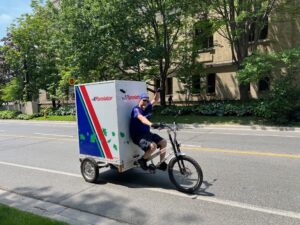
How will Lisa be contributing to this project/your research?
Prof. Roorda: I say it’s my research but it’s really the research we do in collaboration with the City of Toronto, Purolator and others interested in this pilot study. I’m interested in it, and the City of Toronto is also interested in how well electric cargo tricycles operate on campus. We think the use of these e-cargo tricycles might expand dramatically across downtown Toronto and we could see significantly fewer trucks making deliveries. This is why Lisa and our whole team are putting significant effort into analyzing this one pilot study in-depth. We want to show evidence to the City of Toronto and companies like Purolator courier that [electric cargo tricycles] are a win-win-win solution for urban deliveries. I‘m thinking bigger picture – there’s real potential to make a significant impact in real life across the city.
How does this study last in the winter?
Prof. Roorda: My understanding is [the e-cargo tricycles] operate quite well in the winter. The batteries don’t last quite as long in the chilly weather, but they are resilient. And Toronto is not as cold as Montreal, where these tricycles are also operating over the winter – where the temperature is a lot colder and there’s a lot more snow.
Do you have any interesting hobbies or talents you’d like to share?
Prof. Roorda: I can play the piano upside down. Don’t ask me to do that in public.
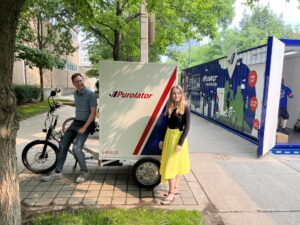
Recognizing a gap in available professional development, CivMin Professor Kamran Esmaeili undertook the task of creating a program of new online courses for mining industry professionals
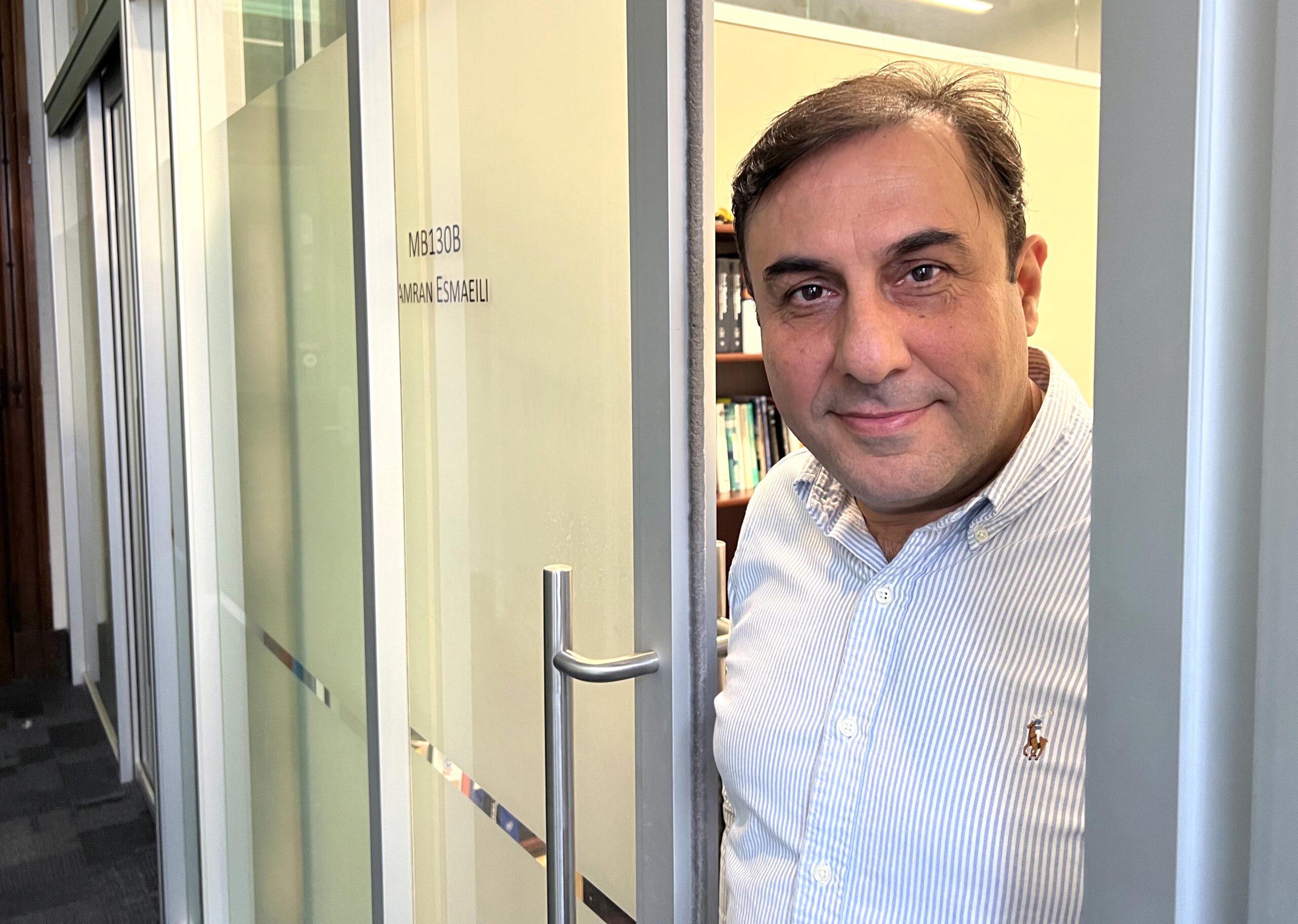
Led by an initiative from Prof. Kamran Esmaeili, a professor in the Department of Civil & Mineral Engineering, a new set of online courses designed for professional development is being released. Targeted to mining industry professionals, the new Mining Industry Management Program (MIMP) at the University of Toronto will hold its first course this fall.
A recent global survey identified learning needs and educational gaps among working mining professionals. Many of these young professionals are unable to pursue further education as they are busy with their careers and often work in remote locations. Distance and time constraints prevent them from physically attending class-based courses. Faced with a skills shortage, due to the retirement of many experienced people, the mining industry is in need of a solution for this shortfall.
 Recognizing the urgency to overcome this, Esmaeili stepped up to the challenge. The last two years involved countless hours of planning, meeting and overcoming bureaucratic hurdles; the result is a partnership with leading industry professionals and academic partners within the mining industry.
Recognizing the urgency to overcome this, Esmaeili stepped up to the challenge. The last two years involved countless hours of planning, meeting and overcoming bureaucratic hurdles; the result is a partnership with leading industry professionals and academic partners within the mining industry.
The new offerings of online professional development courses were identified as being essential to professionals in the field. The delivery of these courses is designed to be fully online and asynchronous so those enrolled can learn flexibly while continuing to work at their busy full-time job. This new set of targeted courses seems to be the right solution for the right audience.
“The global transition to a green energy economy will make huge demands on natural resources – nickel, cobalt, manganese, copper, lithium, etc.,” says Esmaeili. “At this critical time, the industry is losing essential professional skills to retirement.”
He sums up the unique and flexible online classes with, “As the mining industry strives to fulfill this demand, and achieve sustainable growth and productivity over the long term, it faces a variety of technical challenges and will require highly trained, experienced, and adaptable workforce to meet these challenges.”
The new program will offer advanced-level online courses in the areas of exploration, studies, MRMR, ESG, capital development, operations, economics, and finance. This program, taught by widely experienced top industry professionals, will provide real-world scenarios and opportunities to practice problem-solving while focusing on the challenges experienced at the operations and corporate levels.
This is a unique initiative which is able to globally train the next generation of leaders in the industry, as they address critical challenges. The first course offered for Fall 2023 is to be Exploration, Studies, Resources & Reserves. Registration begins August 1.
Watch the introduction video
By Phill Snel
Undergrad summer student research positions explored
The following is part of a series introducing CivMin’s undergraduate summer students to the Department and our greater community.
We explore the students’ projects, motivation and challenges, while providing insights into who they are, and what motivates them, beyond academia. It also highlights the multitude of ways summer research opportunities are approached and implemented under the guidance of our industry-leading CivMin professors.
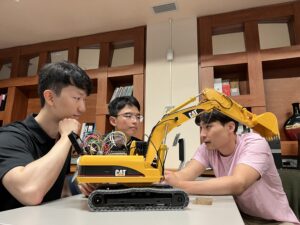
In the course Introduction to Civil Engineering (CIV201), Terry Liang (CivE, Year 3) and Ollie Zhao (CivE, Year 3) had the opportunity to tour campus and visit various professors and research groups. This is when they first learned about Professor Daeho Kim‘s research and knew it was an avenue they wanted to pursue. Prof. Kim ended up being Terry and Ollie’s construction management professor, providing plenty of opportunity for inquiry about potential research opportunities. This summer, Terry and Ollie will be exploring the world of construction management and AI, under the supervision of Prof. Kim.
Tell us a bit about yourself.
Terry Liang: My name is Tianyu Liang. You can call me Terry. I’m a second-year Civil Engineering student, starting my third year this September. Prof. Kim was my professor in second year. [Ollie and I] have been working with him since the beginning of May [2023]. Our summer research is about deep neural network-powered artificial intelligence for construction applications.
Ollie Zhao: I’m a second-year Civil Engineering student, going into my third year [this September]. I’ve been working with Prof. Kim since the start of May [2023].
What will be your role this summer and where? What types of tasks and work will you be doing? And what is the research goal?
Terry: We’re learning Python, doing machine learning courses online and trying to become more familiar with the software we’ll need to support the future steps of our research. For now, we are following instructions from Prof. Kim and Ali Tohidifar [PhD candidate] and trying to learn more about the Blender software specifically. I hope we can help more in the future.
Ollie: To start, we need to [familiarize ourselves] with the various AI systems – the software part of it. We’re learning about Python and trying to get into machine learning. Right now, we‘re working on Blender, which is a 3D rendering software. We’re trying to simulate construction sites in it using Python code. We’re also helping a lot with other students’ research projects. For example, we’re helping Ali label some images and maps. Later [in the summer], we’re going to get more into data generation.
AI on a construction site. It‘s fascinating.
What motivated you to work with Prof. Kim on this project?
Terry: We were in Introduction to Civil Engineering – CIV201 and Ali and [PhD candidate] Sheida Saffari were demonstrating some cool research. Sheida was working on a robotic excavator and Ali was showing us simulations using AI in construction. Afterwards, [Ollie and I] chatted about how interesting it was. It was something we needed to dive into; we needed to talk to this professor. Luckily, Prof. Kim was also our construction management professor, so we got many opportunities to speak with him.
Ollie: For me, it was the start of second year. We had a course, [Introduction to Civil Engineering – CIV201], where we went around the campus and visited various professors and research groups. When I saw Prof. Kim’s research project, I thought, that‘s amazing – AI on a construction site. It‘s fascinating. I knew I had to get involved.
What do you foresee being the greatest challenge?
Terry: Sometimes, we encounter technical difficulties, but we always have each other to talk to and try to find solutions. If we can’t solve the problem, we can always email Ali for help. Every Friday, we also have a meeting altogether and [discuss] everything we think is a challenge – we talk with Ali, we talk with Prof. Kim and we figure out the solution together. So far, we haven’t had any signficant challenges.
Ollie: In terms of technical challenges, it’s more or less human error. If you can’t figure it out on your own, you talk to Prof. Kim or Ali, and everything eventually gets solved. I’m expecting a lot of [technical challenges] in the future but so far, it’s been fairly smooth.
Have you found any favourite spots on campus?
Terry: We play a lot of ping pong with each other [on campus].
Ollie: Pharmaceutical building [Leslie L. Dan Pharmacy Building], on the basement level – there’s a ping pong table there.
Is there anything I haven’t asked you about that you’d like to speak on? Final thoughts?
Terry: Before, when I thought about summer research, I didn’t have a clear image of what it looked like. I thought, maybe we will be given a task to work on the whole summer, maybe we will have a partner, like Ollie. After talking about summer research with Prof. Kim, he gave us many useful suggestions, such as courses. They’re helpful, and we are working on them now. I didn’t expect the good clear instructions we’ve received from Prof. Kim but we’re very happy to be receiving them.
Ollie: The research program is much more educational and interesting than what I initially thought it was going to be. A couple of years back, I would’ve thought – summer research [involves] helping out with some manual tasks, learning some software here and there and that was about it. Having worked with Prof. Kim, [I now know] it’s much more educational. Before, when I was looking at AI stuff, I didn’t know where to find information. Then, Prof. Kim said: here are five specializations and here are courses in Coursera. They’re very educational, build a much more solid foundation and cover all areas I wouldn’t have seen otherwise. That’s just a [minor] example within this research opportunity that’s very educational.
Do you have any interesting hobbies or fun facts about yourself you’d like to share?
Terry: I have a piano at my place and sometimes I teach Ollie piano.
Ollie: [Terry and I] recently bought a little Costco boat and we’re looking to go fishing on the weekends for some carp and bass. We also got a bow and arrow to shoot in the water; it’s legal. Hopefully, we don’t sink our own boat; it’s inflatable.
Questions for Prof. Kim:
What do you hope for Terry and Ollie to achieve this summer? Takeaways?
Prof. Kim: There’s just one thing I hope for [Ollie and Terry] to learn this summer – it’s all about fun. It’s their first year of research. In terms of research value and perspective, the summer is too short for [Terry and Ollie] to have a profound contribution. And the research topic we are doing is not an easy one; few construction researchers can [tackle this one]. We also just started this area of research in 2016 – I was one of the first PhD students to work in this area.
For Terry and Ollie, this is a great opportunity to get a taste of research. For me, I feel a great responsibility as a supervisor in our department. I can motivate undergraduate students and spark more positive thoughts about future research. I also want to prove we can have fun with research. Next year, we will have a different story.
Such things cannot be replaced by AI; they should be done by human resources.
How will Terry and Ollie be contributing to this project/your research?
Prof. Kim: [Terry and Ollie’s] contribution this summer is significant. Our research at this stage requires manual input, manual investigation and manual repetitive experiments with changing parameters. Such things cannot be replaced by AI; they should be done by human resources. Ollie and Terry are taking much of this task on and doing very well. They’ve also suggested a new idea. A few weeks ago, I accepted this idea and we’re working on that too.
Is there anything I haven’t asked you about that you’d like to speak on? Final thoughts?
Prof. Kim: Our research is multidisciplinary which requires knowledge about construction management but also knowledge about virtualization, digitalization and computer science, including computer vision, like low-bias artificial intelligence. To conduct our research, usually it takes a lot of time for students to catch up because [a wide breadth] of knowledge and skills is needed. We also need to deal with many different types of software and the Python-based deep neural network training platform. That’s why I love to start with undergraduate students.
Ollie and Terry were two of the top students in my course last year. They’re also thinking about applying to a graduate program after they graduate. It will take a lot of time to prepare them to conduct this research. If they can start their learning and training during their undergraduate, it will better match the research schedule [for this project and their continued education]. That’s why I love this program. I plan to support their research until their graduation; we will continue our collaboration.
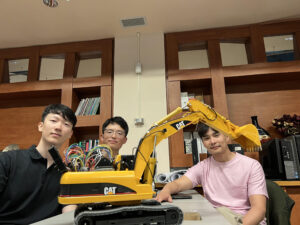
July 27, 2023 | CFJC Today